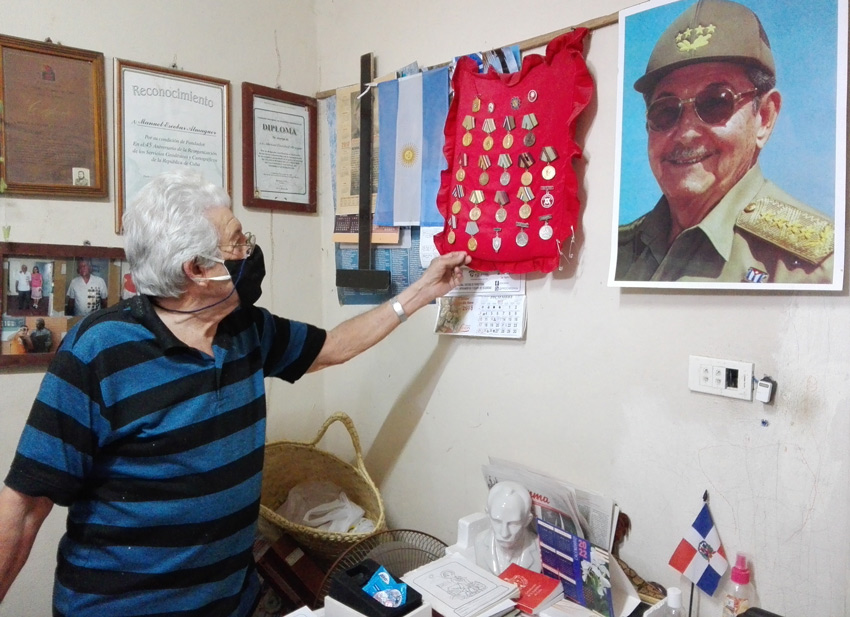
For more than 65 years, Manuel Escobar Almaguer has been part of Cuban history, the one forged since those dark days when many young people woke upshot in any corner of the cities and towns or on the side of the roads.
It was April 1958 and the young high school student was arrested here, in this city that he still travels frequently, despite his 82 years of age. After many family negotiations and even luckily he was released, and then his life became clandestine. Then there was no other road than the one leading to the Sierra Maestra.
"That was in October. We went up there thinking we were looking for weapons and when we met Fidel Castro Ruz he told us he didn't have any. And he sent us to Minas de Frío school until November 8. Then they requested 250 recruits and I was among them."
"We went to La Plata Command and there he told us that we would be in the rearguard, that we would take up arms during the attacks on the barracks. And so it was in Guisa and many other combats until the Triumph of the Revolution."
Those were very exciting moments that Manolito -as he is known in Las Tunas- narrates very fluently to those who are interested in those topics, either at his home on Francisco Vega Street or in schools, so that children know about our history.
He was not in the Freedom Caravan that took Fidel to Havana, because his mission was different. He was sent to the Saturnino Lora Hospital, in Santiago de Cuba, still under construction. Later, to the Morro Castle, and later to the Antonio Maceo airport.
"At the beginning of August 1959, Fidel arrived in a helicopter. I greeted him and also Celia Sánchez Manduley. I took advantage of the opportunity and told her that I wanted to continue studying, although I was willing to do whatever they told me to do. But, they sent me to Havana, to Ciudad Libertad."
"When I arrived, they told me about a surveying course, which they didn't call surveying before. I started, graduated, and joined the Corps of Engineers of the Rebel Army. They gave us the task of doing surveys to build housing for the workers in the sugar mills."
"I worked in seven places and, when I finished, they gave me a pass to come and see the family. When I returned, they asked for three volunteers to work in Cayo Largo, to do surveys for tourism development. And I went there; we went through many situations, but we did what we had to do."
The then Cuban Institute of Cartography and Cadastre, attached to the Ministry of Public Works, passed to the Revolutionary Armed Forces and they asked for 18 comrades. Manolito was also there, performing various functions until he retired from what was then the Cuban Institute of Geodesy and Cartography.
But, during that extensive working life there were other important moments for this humble man, personally, and for Cubans in general. Two of them were the Fight Against Bandits and the U.S. invasion of the sands of Playa Girón.
"When we were in Matanzas, in Colón and Calimete, at night we thought the militiamen how to march and how to shoot. There we knew about the Campito and Tondike uprising and we went out to chase them. We surround them and they were leaving."
"From there we went to Cienfuegos, Las Villas and Sancti Spíritus, in the Escambray. In March '61 we were demobilized and a few days later, the events of Girón. That was when I was in Cienfuegos and there I saw Fidel again, who told us to be on the lookout for a possible landing in the southern zone. He even said that they could enter through Girón."
"Some were sent to Australia sugar mill, others to Girón, on watch. When we were warned of the invasion we organize ourselves and crossing the bay we saw the planes with the Cuban flag, bombing. We were scouting and advancing at night, to avoid deaths."
"History has said it. We lost many comrades, but we gave the enemy a good defeat when we took San Blas. And from there we advanced to Giron. With us, Fidel. When we arrived, Gallego Fernandez (Jose Ramon Fernandez Alvarez) and the National Revolutionary Police (PNR, by its acronym in Spanish), with Efigenio Ameijeiras Delgado, were already there."
"Then, the order was to make sieges to catch the mercenaries who were hiding throughout the swamp and respect their physical integrity, because that was one of the main precepts of Fidel, from the Sierra and throughout the revolutionary process."
The outstanding man from Las Tunas was all over Cuba, sometimes in work functions and other times as a combatant. But, in every place, he was doing good for the generations that since then have continued defending the sovereignty of the nation.
Today he is accompanied by his wife of 58 years, three children, and three grandchildren. All of them studied and became professionals, under the enormous example of the family fork, who remains active for the Homeland and the Communist Party of Cuba.
Many, many times, under the heat of the bullets, his life was in danger; however, he never thought of retreating to the comfort of his home. Today he looks at his medals with intense pride and rightly so. Few Cubans are combatants of the underground, the Rebel Army, the Fight Against Bandits, and Playa Girón (Bay of Pigs).
"To paraphrase Nicolás Guillén, I have what I must have. And for that, I fight and I will fight until the last breath I have left."






